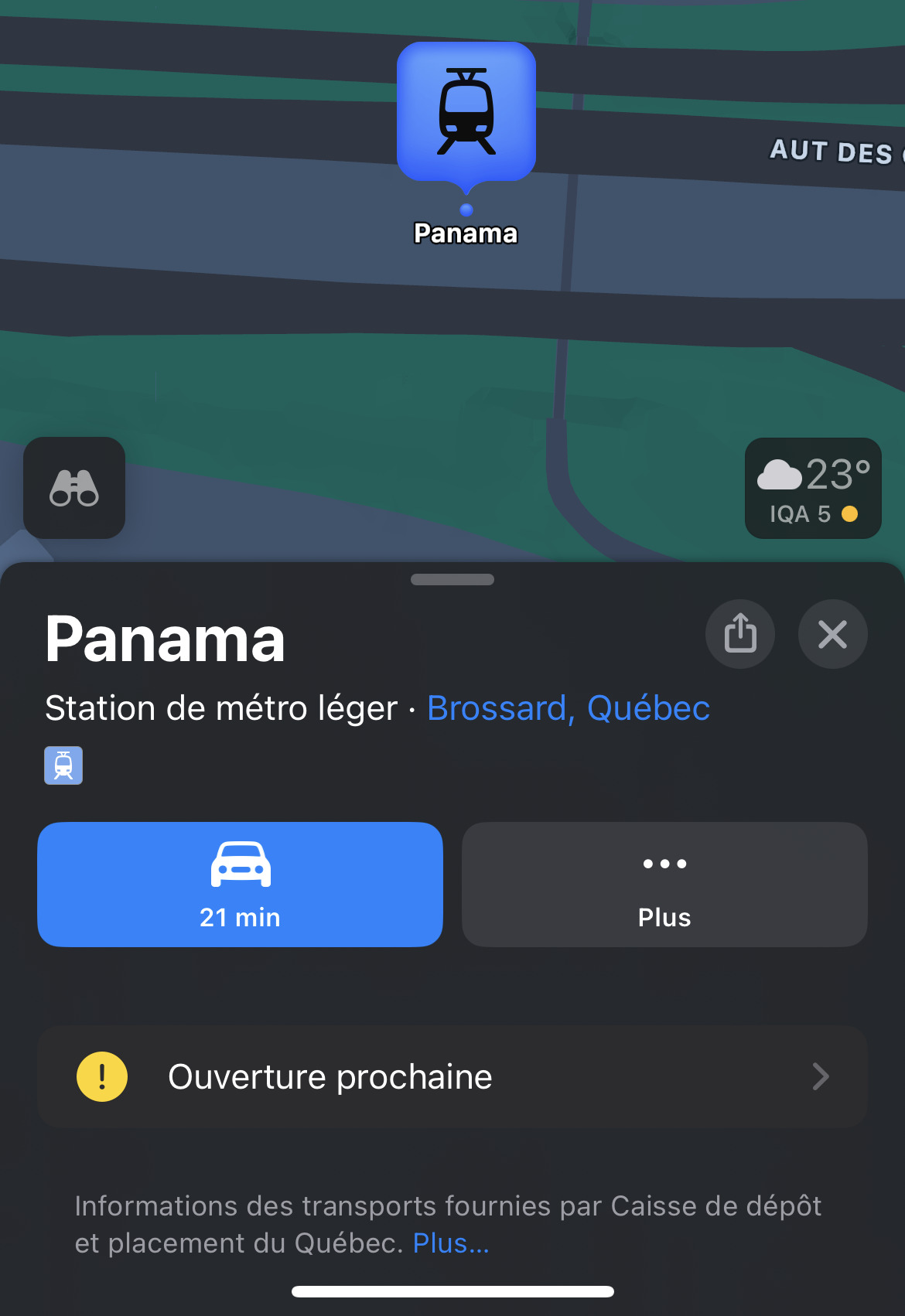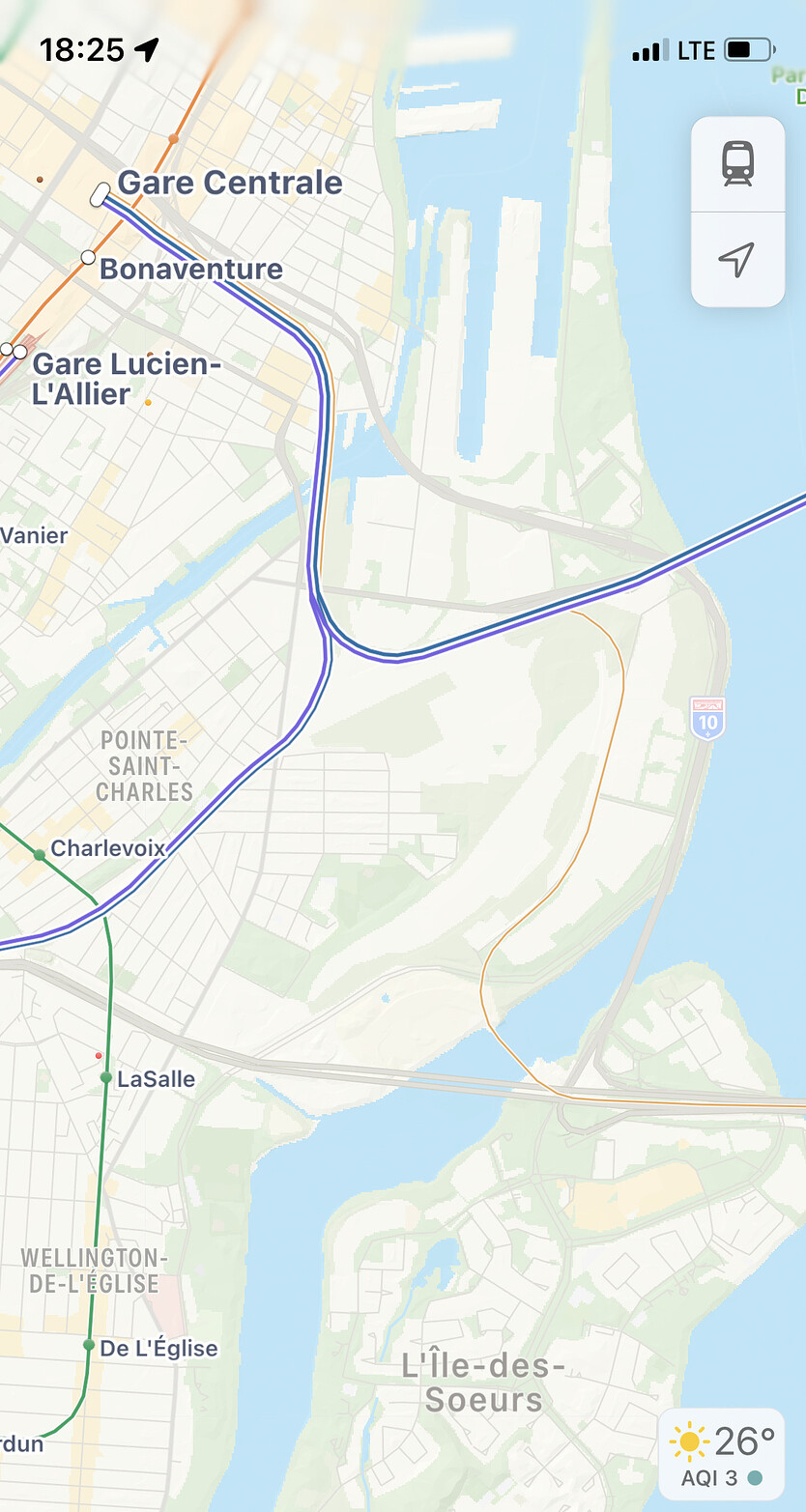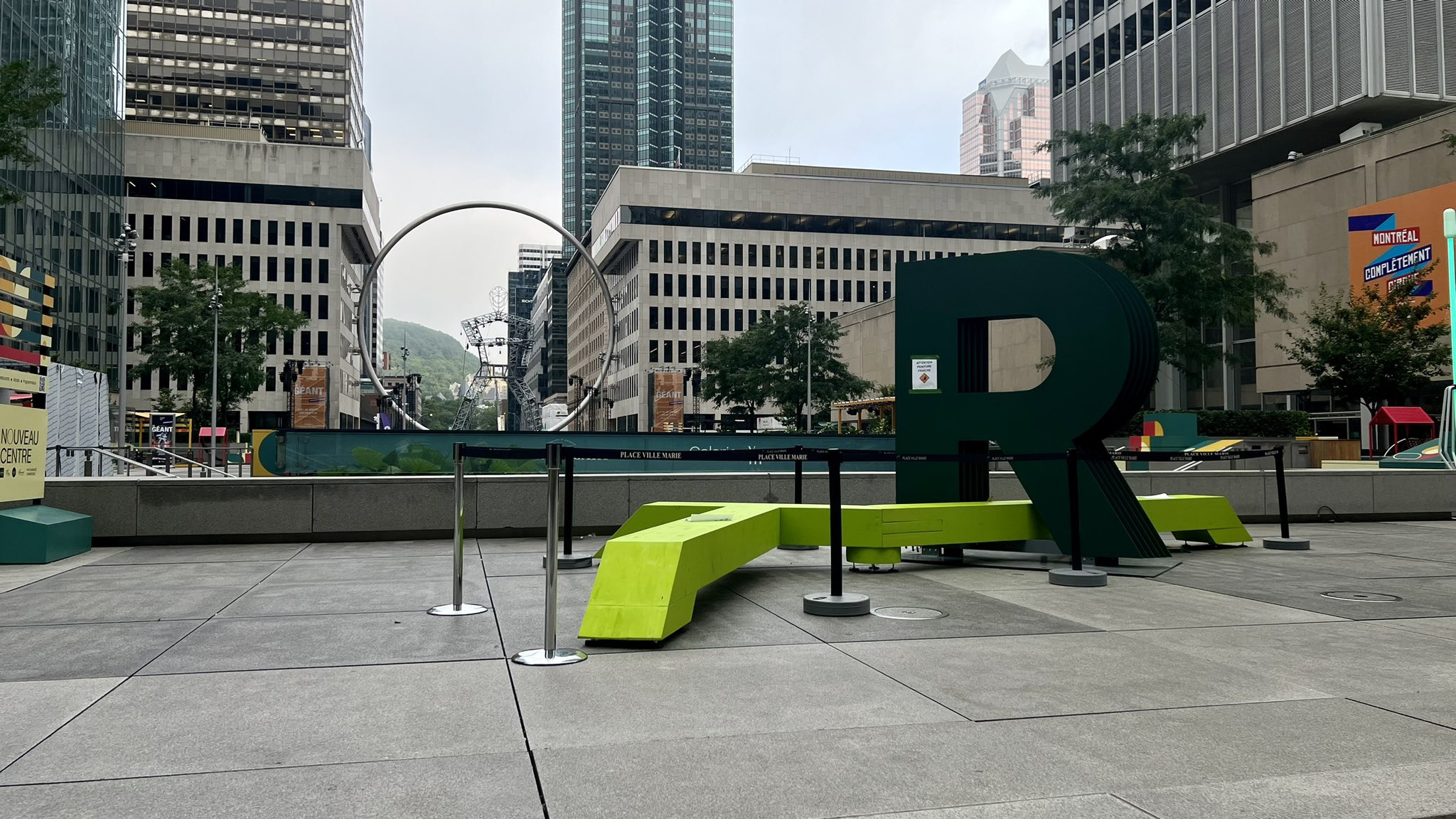Oui, c’est le 31 le premier jour payant.
Qu’est-ce-que vous pensez de ce vidéo. Est-ce-que les amortisseur sont si efficace ou c’est juste parce que le REM s’éloigne. Dans les vidéo auparavant le bruit était beaucoup plus élevé sur le segment enjambant le canal que celui ou il y a un mur.
https://twitter.com/Olivier73771677/status/1681823430658670594?s=20
With an exception! Bus fares are accepted on the first day
Journaliste pas capable d’aller vérifier sur le site Web du REM pour avoir les bonnes dates…
L’événement inaugural se déroulera en 3 temps :
- Vendredi 28 juillet : Cérémonie protocolaire de 9 h à 12 h, à suivre en direct (Cliquez ici pour vous inscrire)
- Week-end gratuit du 29 et 30 juillet : portes ouvertes pour le grand public de 9 h à 19 h
- Lundi 31 juillet : début de la mise en service officielle
Donc, pour vendredi :
9 h à 12 h coupage de ruban avec les dignitaires
13 h : visite avec les personnes qui ont gagné le concours
14 h : visite avec les partenaires du REM (ex. élus des diffiérents paliers et autres invités)
Ajout : le titre de l’article a été corrigé
Il y a vraiment une coupe net dans le son. Je dirais qu’il ont trouver quelque choses de prometteur.
C’est un peu trop tard pour cela, mais il existe une autre solution que j’ai découvert récemment pour contrer le bruit d’une voie ferré sur un viaduc. Une couche de bitume caoutchouc en dessous des dormants.
Apple Maps displays a temporary icon for the REM, as well as “Station opening soon”
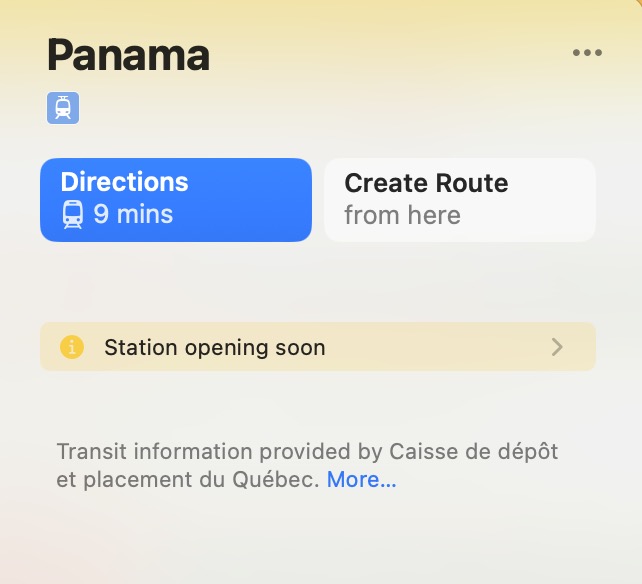
When you open it, it links to a CBC article that says the date lmao:
Apple Plans indiqué que c’est une “station de métro léger”. On en a déjà parlé mais pourquoi affubler le REM du terme “léger”? Au moins c’est mieux qu’un “train léger”.
I agree, I think it should be just classified as “Train Station,” like they do with the SkyTrain, which is similar to the REM.
who else is with me in taking this up… i bought RTL tickets just before they finally announced the date and have like 15+ trips to use lol (combination of WFH and vacation made it less used than I envisioned)
I wish they would write it officially on the REM.info site so hopefully won’t get harassed
I will note that Apple has added the REM line to their maps as well, on top of the service notice and stations.
It’s a faint orange line, but it is there.
Update sur l’ouverture des sites extérieurs des stations
- À Brossard, les cônes sont présentement en train d’être enlevés, mais la sécurité demeurera présente et la police s’en vient sécuriser le périmètre pour demain. Bref, fermé.
- À Panama, le site extérieur est ouvert d’un bord.
- À IDS, le site extérieur vient d’être ouvert du côté Sud
- À GC, les barrières ont enlevées à l’entrée, mais on ne voit pas grand chose
Question!!!
Si vous allez aux portes ouvertes samedi matin, vous embarquez à quelle station?
- Gare Centrale
- Île-des-soeurs
- Panama
- Du Quartier
- Brossard
0 votant
Dans le Globe & Mail
Design, build, operate: In Montreal, Caisse’s new infrastructure model gets its first test
NICOLAS VAN PRAET
BUSINESS REPORTER
PUBLISHED 4 HOURS AGO
UPDATED 36 MINUTES AGO
Open this photo in gallery:
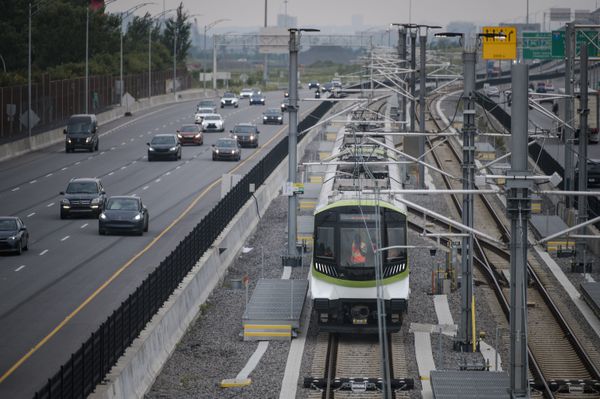
The REM (Reseau Express Metropolitain) passing beside the highway through Brossard on July 26. The project, first unveiled in 2016, will finally open its doors to the public on July 31 and will have a soft launch on July 29 and 30. The first phase will connect Montreal’s Central Station to Brossard in the South Shore. It is also planned to extend to the airport and various other boroughs.ANDREJ IVANOV/THE GLOBE AND MAIL
Montreal’s biggest public transit project in more than half a century is about to open – a monumental moment for its financier and builder, the Caisse de dépôt et placement du Québec. Now, the pension fund giant will have to prove it can continue to lure people out of their cars if it wants a crack at winning other projects in the future.
The first 17-kilometre branch of the Caisse’s Réseau express métropolitain (REM) light rail line will welcome dignitaries and media Friday and its first paying customers Monday, ferrying them between Montreal’s south-shore suburbs and central station at a speed three times faster than by automobile.
Two other sections are slated to carry their first passengers by the end of next year while the final leg to Trudeau International Airport is expected to open in 2027.
Not since Montreal’s rubber-wheeled metro system launched 57 years ago has Quebec seen a transit project of this size and novelty: A network spanning 67-kilometres in length, all electric and driverless, operating 20 hours a day, every day. With a price tag well above $7-billion, it will be, as Caisse chief executive Charles Emond has proudly touted, among the longest automated light rail lines in the world.
“This is a historic project,” Mr. Emond said in April on popular talk show Tout le monde en parle. “It’s going to change the city and the relationship we have with the city,” he said, acting as a catalyst for economic and real estate development.
For Montreal, a town plagued by chronic transportation issues, the REM can’t come soon enough. Aside from the metro, which generally works well, aging infrastructure on major highways and bridges causes traffic snarls. In addition, commuter rail lines have to share tracks with freight rail and, unlike other major cities globally, there’s no reliable transit link between the city core and the airport.
Senior leaders of the Caisse recognized that Canada’s second biggest city was in danger of falling badly behind on infrastructure development if nothing was done. In 2015, then Caisse CEO Michael Sabia persuaded the Quebec government that the Montreal-based pension fund manager could build and operate a new light rail network.
The idea was an innovative one in theory. The Quebec government could get a new transit system without assuming public liability for cost overruns that often come with such projects, while the pension fund gets a stable return and develops expertise it can then pitch to other governments for future work. A deal was struck soon after and construction started in 2018.
Caisse’s heavy hand shapes Montreal’s transit future
Under the pact, the Caisse’s infrastructure arm is assuming $3.5-billion of the project’s $6.9-billion construction cost while Quebec is committing $1.28-billion and the Canada Infrastructure Bank is providing a $1.28-billion loan. The balance consists of a $295-million payment from Hydro-Québec for the line’s electrification, while the Autorité régionale de transport métropolitain, the transit authority for the Montreal region, is pledging $512-million.
When the Caisse announced the start of construction on the REM, it pegged the project cost at $6.3-billion, an amount that has since climbed and now tops the latest official $6.9-billion projection. It has promised to update the financial information in the days to come.
Provincial and local governments will provide continuing operating subsidies for the REM to make sure the Caisse earns its required return on the project, currently pegged at 8 to 9 per cent. The pension fund manager will get 72 cents for each passenger-kilometre travelled on the light rail system. Without such a subsidy, fares would climb to a level few passengers could afford.
Open this photo in gallery:
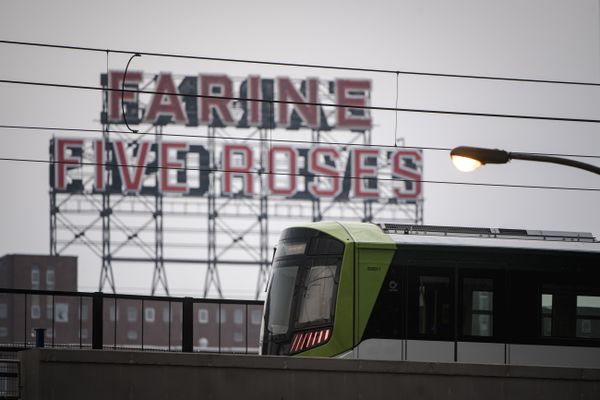
An REM train passes through Griffintown in Montreal. The REM has caused some controversy in a few boroughs, such as Griffintown, where some residents complained of the excessive noise.ANDREJ IVANOV/THE GLOBE AND MAIL
That the first piece of the REM is opening now, five years after construction started, is a victory of sorts for the Caisse and its partners – even if it comes roughly two years late. There have been a myriad of issues to deal with for those working on the project, including an unexpected detonation of century-old explosives inside the Mount Royal Tunnel, new worker protocols caused by the pandemic, and the rapid rise in inflation.
Other transit projects around the world have been scrapped in recent months over concerns about ballooning costs, such as plans for a rail link connecting New York City’s subway and commuter rail systems to LaGuardia Airport. But the REM is forging ahead in its own imperfect way, drawing both hope for its economic and environmental benefit, and criticism for how the project has been conceived and handled.
“What annoys me is that there was almost an arrogance when this process started by the Caisse that ‘We know what we’re doing, we’re going to be better than others, we’re going to do it on time and on budget.’ Today it’s clear that’s not the case,” said Jacques Roy, a transportation specialist at Montreal’s HEC business school. “We could see another project like this again but I’m not sure we should,” he said about the Caisse’s leadership.
That the REM is seeing the light of day is due in no small part to the wide berth the Quebec government offered to the Caisse, including expropriation rights and political backing despite a negative assessment of the project from the province’s environmental review board, Mr. Roy said. The transit line was also launched without worrying too much about how it will connect with the rest of the public transport network, he said.
Nathalie Drouin, a professor who studies project management at the University of Quebec at Montreal, said giving the Caisse a mandate for the REM wasn’t necessarily a bad thing. But the pension fund manager could have, and should have, done things differently in engaging stakeholders and stickhandling the project as an asset for the public good, she said.
Montrealers living near the REM tracks are voicing concerns that the trains – which have been undergoing testing for months – are too loud. And the design of the infrastructure itself, featuring massive concrete columns erected to support the elevated tracks, leaves much to be desired, Ms. Drouin said.
“Could we have done better? Yes,” she said.
In sum, the Caisse handled the financial and technical risks for the project well but mishandled the social risk, Ms. Drouin said. “By using the REM, people might come to appreciate it. But the question is would I hire the Caisse again to do another similar project? … I don’t know.”
The federal government might soon face that choice. Ottawa last week released a short list of private-sector bidders to build a high-frequency passenger rail line between Quebec City and Toronto, and a consortium including the Caisse is one of three finalists for what would be one of the largest infrastructure projects in Canadian history.
The federal government is paying close attention to the lessons learned from the REM as it pursues its own project, said Ehren Cory, CEO of the Canada Infrastructure Bank. Other cities are keeping tabs on the REM as well as they think about the long-term economic value of transit and the value it creates creates, he said.
The REM alone has contributed to $5-billion worth of real estate development on Montreal’s south shore over the past three years, three times the pace the Caisse had predicted. Mr. Emond calls it “a spinal cord” anchoring the region’s suburbs.
“Hopefully when we get to the light at the end of this tunnel and people see a train and a system running, it is an example for other municipalities, provinces, to see how we can get more infrastructure built,” Mr. Cory said in an interview.
“We’ve got to get more built faster than we are. And the reason we’re not isn’t for lack of effort. It’s partly because we can’t afford it all unless we think differently about how we pay for stuff,” he said.
The Caisse has said it wants to expand its infrastructure arm and build more projects like the REM from scratch, eking out a reputation as a go-to partner for governments. But as it opens the next arms of the transit line, it will have to overcome another hurdle: Unknowns related to ridership.
The pandemic has changed the habits of Montreal’s white-collar professionals, who continue to work from home in great numbers. Although workers are slowly coming back, nearly 1 in 3 told the city’s chamber of commerce in recent polling that they do not want to come downtown to work, a desertion of the city centre that could yet wreak havoc on REM revenues.
The Transportation Research at McGill group has been studying the impacts of the REM on mobility, health and equity. Among its key findings from surveys in a report published in June, it says people’s stated intentions to use the REM fell by 7 per cent between 2019 and 2022. In terms of travel behaviour, car-use frequency increased by 59 per cent over the same time, its research found.
“Any transit system construction right now is good because you want people to be using it,” said Hisham Negm, a doctoral student working on the research. “But is it the right time to be building a system that should be carrying 60,000 or 80,000 people a day and you’re not sure whether you’re going to get this ridership or not? It’s questionable.”
Mr. Emond says the system will prove its worth. And he says additional testing of the Alstom SA-made Metropolis trains over the past winter in Montreal, where it was exposed to freezing rain and minus-40 cold, should ensure the system doesn’t experience the frequent breakdowns seen in other places like Ottawa.
“This is Metropolis on steroids,” Mr. Emond said. “There’s never been a train run like this in a rigorous climate with such temperature extremes. We’re confident it’ll react well.”
I wonder why they haven’t released the open data of the REM yet, it seems really short notice. I think Transit got it just because they were working together for the preview feature, I wonder if they made an agreement to not release the data to others until a certain date to get people to use Transit (I doubt this though)
Yup. Exceptionalism.
CDPQ Infra se porte à la défense du REM, à quelques heures de son inauguration
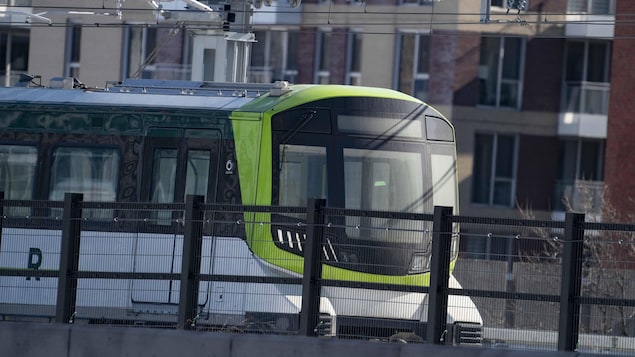
Selon les dirigeants de la CDPQ et de la CDPQ Infra, il s’agit du « plus gros, plus grand et plus long métro léger automatisé au monde ».
PHOTO : RADIO-CANADA / IVANOH DEMERS
Radio-Canada
Publié à 2 h 13
À la veille de l’inauguration du REM, la Caisse de dépôt et placement du Québec (CDPQ) et CDPQ Infra, sa filiale chargée du projet, se sont à nouveau portées à la défense de leur projet en réaction aux nombreuses critiques concernant l’explosion des coûts et les retards dans la mise en service du réseau de train léger desservant Montréal et certaines de ses banlieues.
En entrevue à Radio-Canada, les présidents et chefs de la direction de la CDPQ et CDPQ Infra, Charles Emond et Jean-Marc Arbaud, ont profité de l’occasion pour aborder la question des succès du REM.
M. Emond a particulièrement insisté sur l’expertise générée par ce train léger et sur la performance de ce dernier, notamment avec les partenaires internationaux qui ont contribué à la réalisation du plus gros, plus grand et plus long métro léger automatisé au monde.
Ce que je veux que les Québécois retiennent est que, oui, il va y avoir des dépassements de coûts dans un contexte comme celui-ci, mais d’une façon relative, on a une très bonne performance. On a prouvé qu’on peut réaliser ce genre de projet au Québec et on a bâti une expertise.
Une citation deCharles Emond, président et chef de la direction de la CDPQ
Pour sa part, M. Arbaud affirme que la mise en service du REM a été tout un périple, accompli dans un temps record si l’on pense aux deux ans de pandémie.
Entrevue d’Alexis De Lancer avec Charles Emond, président et chef de la direction de la Caisse de dépôt et placement du Québec, à la veille de l’inauguration du REM, vendredi, à Montréal. L’institution est maître d’oeuvre du mégaprojet de transport en commun.
Un projet qui est là pour les 100 prochaines années
Le 22 avril 2016, l’ancien PDG de la CDPQ, Michael Sabia, avait promis que la construction du REM serait lancée au printemps 2017, avec comme objectif une mise en service à la fin de 2020. Il avait d’ailleurs ajouté qu’il n’est pas vrai que les Québécois sont condamnés à des retards et des dépassements de coûts.
Or, la détonation d’explosifs centenaires dans le tunnel Mont-Royal, la pandémie et l’inefficacité du tunnelier à creuser en milieux humides près de l’aéroport Montréal-Trudeau sont tous des éléments qui ont grandement retardé sa mise en service. Celle-ci aura finalement officiellement lieu cette fin de semaine, pour le tronçon entre Brossard et Montréal.
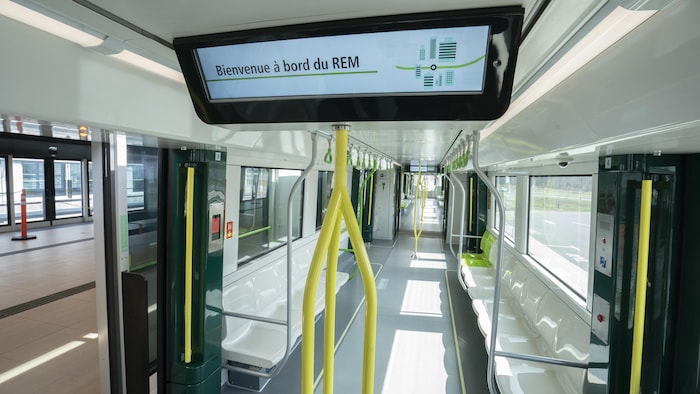
La mise en service du REM a été repoussée au 31 juillet pour le tronçon reliant Brossard et Montréal.
PHOTO : RADIO-CANADA / IVANOH DEMERS
Selon M. Emond, les retards, l’augmentation des coûts et les changements d’habitudes de déplacements depuis la pandémie ne viendront toutefois pas compromettre la rentabilité du REM, puisque celui-ci finira par devenir une option plus intéressante que la voiture.
Il y a énormément de transport qui est effectué par des étudiants à des heures atypiques. Il y a le télétravail qui entraîne aussi des horaires différents. Fonctionnant 20 heures sur 24, ce projet de transport structurant va peut-être nécessiter une période d’adaptation de 4 ou 5 ans pour revenir à un niveau d’achalandage prépandémique. Mais ce projet est là pour les 100 prochaines années, et on n’a pas d’inquiétude que le trafic atteigne le niveau qu’on a projeté, dit-il.
Toujours au dire de M. Emond, il n’existe aucun plan de vente de tronçons du REM à des exploitants privés si jamais la rentabilité n’est pas au rendez-vous, bien que cette clause existe dans le contrat du projet.
À la veille de l’inauguration officielle du REM à Montréal, Radio-Canada a effectué un voyage au centre du réseau avec les grands patrons du réseau, à savoir les présidents et chefs de la direction de la Caisse de dépôt et placement du Québec (CDPQ) et de CDPQ Infra, Charles Emond et Jean-Marc Arbaud. Ils ont profité de l’occasion pour aborder les différents défis du REM.
Un système géré à distance
M. Arbaud a aussi rappelé que le train fonctionne sans conducteur et que l’ensemble du système est connecté à un cerveau, soit le centre de commande où les opérateurs gèrent le réseau de transport.
Par ailleurs, une série de caméras permettent aux opérateurs de savoir, en tout temps, ce qui se passe sur les lignes du réseau, a-t-il ajouté.
Les gens vont se rendre compte que c’est un métro léger automatisé qui n’a pas de conducteur. C’est comme un grand ordinateur avec un centre de contrôle qui assure sécurité et fiabilité. Les gens vont voir les wagons, c’est très épuré, les trains sont à l’extérieur, donc c’est bien illuminé. Le REM offre aussi une belle vue et une belle perspective sur Montréal et la Rive-Sud, a résumé M. Emond.
Bien que la facture finale soit toujours inconnue, elle dépassera assurément les 5 milliards de dollars prévus initialement. Le REM devrait finalement être relié à l’aéroport Montréal-Trudeau d’ici 2027.
Le public est invité à monter à bord du REM gratuitement les 29 et 30 juillet avant sa mise en service officielle, prévue pour le 31 juillet.
Avec les informations d’Alexis de Lancer et de Mathieu Prost
Ça s’installe pour l’inaugurationà Brossard
Sur le compte Twitter de la chroniqueuse circulation de Radio-Canada, Sarah Murphy
https://twitter.com/mmesarahmurphy/status/1684888024679927809/video/2
Sur l’esplanade de la Place Ville-Marie aussi
Source : https://twitter.com/VanishingUnder/status/1684885466787823617
L’animateur de l’événement inaugural qui appelle le REM, le R.E.M… ![]()
![]()

